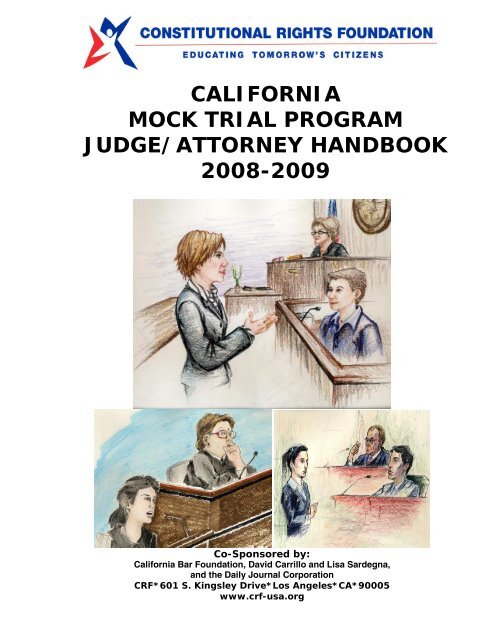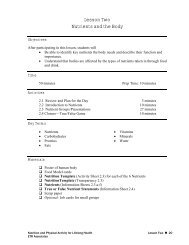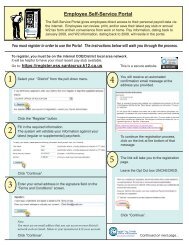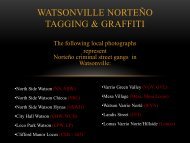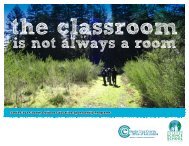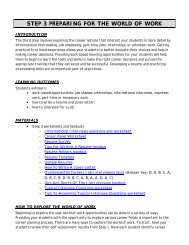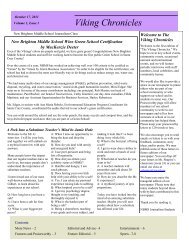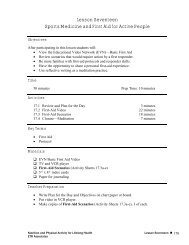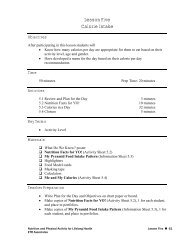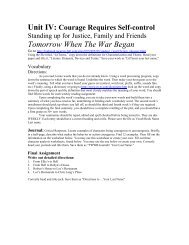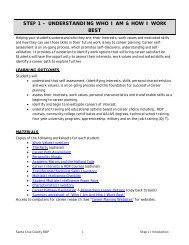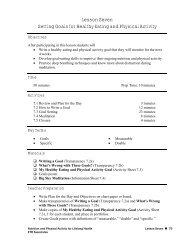Mock Trial Judge Attorney Handbook 2009 - Santa Cruz County ...
Mock Trial Judge Attorney Handbook 2009 - Santa Cruz County ...
Mock Trial Judge Attorney Handbook 2009 - Santa Cruz County ...
Create successful ePaper yourself
Turn your PDF publications into a flip-book with our unique Google optimized e-Paper software.
RNIA MOCK TRIALCALIFORNIAMOCK TRIAL PROGRAMJUDGE/ATTORNEY HANDBOOK2008-<strong>2009</strong>Co-Sponsored by:California Bar Foundation, David Carrillo and Lisa Sardegna,and the Daily Journal CorporationCRF*601 S. Kingsley Drive*Los Angeles*CA*90005www.crf-usa.org
TABLE OF CONTENTSIntroduction..............................................................................................3Instructions for <strong>Attorney</strong>s and <strong>Judge</strong>s ..................................................3Scoring and Procedural Reminders .......................................................4General Tips for <strong>Attorney</strong> and <strong>Judge</strong> Volunteers ..................................7Script For Presiding <strong>Judge</strong> .....................................................................8Summary of Pretrial Motion Procedures.............................................. 11Summary of <strong>Trial</strong> Procedures ...............................................................12Scoring ProceduresEvaluation Criteria ........................................................................13Scoring Criteria............................................................................ 152
INTRODUCTIONThank you for agreeing to serve as an attorney scorer or judge for ConstitutionalRights Foundation’s California <strong>Mock</strong> <strong>Trial</strong> program. The program reaches over8,000 students from around the state and involves thousands of members fromthe bar and bench. As a volunteer, you are an invaluable part of an extraordinarylearning experience for California’s young people.Students have labored for months preparing this year’s case and they value yourcomments and scoring of their presentations. Your role as a mock trial volunteeris critical to creating a positive learning experience, so it is crucial that yourfeedback be fair, helpful and positive. Your comments and accurate scoring ofthe trials you review are fundamental to making the mock trial an educationalexperience for all the students involved.INSTRUCTIONS FOR ATTORNEYS AND JUDGESBEFORE THE COMPETITION:Please review the Facts, Pretrial Argument (Only applicable to high school trials)and witness statements. All scoring attorneys and presiders are expected to befamiliar with these materials.♦ Presiders, please review the mock trial scoring and procedural reminders andthe summary of pretrial and trial procedures in this packet.♦ Scoring attorneys, please review the mock trial scoring and proceduralreminders, and evaluation and scoring criteria in this packet.ORIENTATION: Each individual county may or may not conduct volunteerorientations. In Los Angeles <strong>County</strong> and at the state competition, there will be amandatory 10 minute orientation session prior to the start of each round ofcompetition. The orientation will cover basic rules, last-minute instructions, andtrial assignments.ATTORNEY SCORERS: Generally, your role is to numerically score thepresentation based on the criteria in this handbook. You will also be asked toprovide positive and constructive comments to students at the conclusion of thetrial.JUDGE/PRESIDER: The role of the judge is to preside over the trial and helpstudents to relax and enjoy this educational experience. As the presider, youwill make all decisions regarding the running of the trial, including ruling on the3
pretrial argument, ruling on objections, ruling on competition violations andannouncing a verdict (the verdict is independent of which team may havewon/loss the trial).SCORING AND PROCEDURAL REMINDERS1. It is very important to read the fact situation and witness statementscarefully. Because this is a mock trial, students will refer to specific factsand make references to certain pages in the text, and you need to befamiliar with the pertinent details.2. Before the trial, a student from each school will present a teamroster/award nomination form to the judge and scoring attorney(s). Thisform will have names and designated trial roles. If you feel a student did anoutstanding job, please place a check by the student’s name on thenomination form.3. Please keep in mind that the mock trial competition involves timedpresentations. One team’s unreasonable running of the opposing team’stime is inappropriate. If witnesses are deliberately not responding toquestions, they may be admonished and receive point deductions, andpoor sportsmanship may be reflected in the team performance score.4. SCORESHEETS/TIE-BREAKERa. Please fill in every box on the score sheet. No fractions are allowed.b. When filling out score sheets, please make your decisionsindependently. There should be no conferring with other attorneyscorers.c. After every trial, the presiding judge must complete the purple-tiebreaker form and indicate which team she/he feels should be the overallwinner in case the scores determine a tie. Do not announce scores ortiebreaker information to the teams.6. WITNESSESa. The official source of information for witness testimony includes awitness’s own statement, all stipulations and exhibits, and any portion ofthe fact situation of which that witness reasonably would have knowledge.A witness may testify only to facts stated in or reasonably inferred from4
these official sources. Reasonable inferences should be limited, andstudent’s should not create facts that are material to the case.b. Witnesses are not allowed to use notes when testifying.c. The witness statements contained in the packet should be viewed assigned statements made to the police by the witnesses. Witnesses canbe impeached if they contradict the material contained in their witnessstatements. This rule is designed to limit, not eliminate, the use ofreasonable inference by providing a familiar courtroom procedure.d. Witnesses will remain in the courtroom for the entire trial, in designatedseating at the front of the courtroom.e. Unless otherwise specified, witnesses may not testify or respond toanother witness’s testimony.f. Once the trial has begun, contact is prohibited between a witness andany other team member, teacher, parent or school representative. Theonly communication allowed during the trial is between trial attorneys onthe same side. Additionally, the defendant may sit at counsel table andcommunicate with the defense attorneys. All communication must benon-disruptive to the trial. Pretrial attorneys may not communicate withthe trial attorneys at any time. Any contact forbidden contact with teammembers, coaches or spectators will be a deduction of five points perscore sheet.g. All witnesses must be called. Cross-examination is required for allwitnesses. If the direct examination team runs out of time without callingone or more witnesses, the cross-examination team will be automaticallyawarded five points for each witness not called, and the directexamination team will automatically receive a score of zero.7. PRETRIALa. The pretrial motion is designed to help students learn about the legalprocess and legal reasoning. Although mandatory in the State Finals andin Los Angeles <strong>County</strong> for High School trials, the pretrial motion isoptional at the local level. The county coordinator will inform you whetherthis will be part of the local competition. Tb. There are no motions permitted in the trial except for the pretrial motionand motion to move exhibits into evidence. No written pretrial motionmemoranda may be submitted to judges at local or state levels. If amotion is made, two points will automatically be deducted from the team’stotal performance score.c. Additional background research may supplement students understandingof the pretrial issue, but such supplemental materials may not be cited inarguments.5
d. No objections are allowed during pretrial arguments. Points may bededucted for objections made during pretrial arguments.8. ATTORNEYSa. <strong>Attorney</strong>s may conduct re-direct examination when appropriate. No recross-examinationis allowed.b. Only the direct and cross-examination attorneys for a particular witnessmay make objections during that testimony. Points may be deducted forobjections made by the wrong attorney.c. To maximize the educational value of the mock trial experience, allowstudent-attorneys to argue evidentiary objections before rulings are made.9. At the conclusion of the pretrial and again at the conclusion of the trial, oneattorney from each team has 30 seconds to confer with the attorney coachand teacher sponsor and 30 seconds to orally note any rule irregularities tothe court. It is the judge’s responsibility to determine whether or not a ruleviolation occurred and if so, to direct the scoring attorneys accordingly.Before ruling, we strongly encourage judge’s to have teams direct them tothe page in the rulebook that states the rule allegedly violated.10. At the conclusion of the trial, comments of presiders and attorneys shouldbe limited to a total of 10 minutes. Informal comments may be made oncestudents have been dismissed.11. Costumes, theatrical makeup and phony accents are prohibited. In keepingwith the educational philosophy and objectives of the <strong>Mock</strong> <strong>Trial</strong> program,teams should concentrate on presenting the trial in a realistic manner, withwitnesses wearing appropriate courtroom attire and speaking in theirnormal voices.12. Gender-neutral names allow students of either gender to play the role of anywitness. Any questions regarding gender, race, or physical characteristicsnot included in the official case materials are not allowed.13. All trials at the state and Los Angeles <strong>County</strong> competitions are bench trials.Please do not make any jury references as students have prepared forbench trials.6
GENERAL TIPS FOR ATTORNEY & JUDGE VOLUNTEERSDO’s:DON’TS:Do be fair.Do try to help the students relax. Remember this is supposed to be apositive experience for them!Do offer a few words of encouragement or insight into the trial processbefore the trial begins. This will help put the students at ease, and byemphasizing the educational, rather than the competitive aspects of themock trial, you will help to bring the experience into proper perspective.Do give positive and constructive feedback at the conclusion of the trial.Do not lecture the students.Do not ask students to comment on cases, trial procedures or informationnot included in the case packet.Do not give negative comments.Do not announce a winner.Please Keep in Mind…• <strong>Mock</strong> trial students take their work and efforts very seriously. <strong>Judge</strong>sand attorneys should be equally as serious about their roles andresponsibilities. You are in a position of great influence with respect tothe students’ evaluation of their work and themselves.• Your comments are very important to the students who participate, soplease be positive and constructive. Students are likely to take suchcomments to heart. Being mindful that the participants are middleschool or high school students and not college or law students, and thatmock trial is a law-related education function, judges/attorneys shouldstrive to educate and inform participants as well as to give them adviceon improving their performances.THANK YOU FOR YOUR DEDICATION TO THE YOUTH OF CALIFORNIAAND WE HOPE YOU ENJOY YOUR MOCK TRIAL JUDGING/SCORINGEXPERIENCE!7
SCRIPT FOR PRESIDING JUDGENOTE: This script incorporates some of the unique instructions of the mock trialcompetition. Please feel free to use all or portions of this script during the trial.OPENING REMARKSA few words of welcome or insight into the trial process can help but the studentsat easeINTRODUCTIONS“To help myself and the attorney scorers, will the Prosecution team please stateyour name and role?” “Defense team please state your name and role.”INSTRUCTIONS“You must complete your presentations within the specified time limits. The clerkwill signal you as your time for each section of the presentation begins to run out.When your total time for each section runs out, you will be stopped, even if youhave not finished. <strong>Attorney</strong>s must call four witnesses.“At the end of the trial I will render a verdict of guilty or not guilty in relation to thecharge brought. The teams will be rated based on the quality of theirperformances, independent of my verdict.”“Barring unforeseen circumstances, no recesses will be called. If for any reasona recess is necessary, team members should remain in their appropriate placesand should have no contact with spectators.”In the interest of time, would both sides like to waive the reading of the evidenceand stipulations?” (If not read the evidence and stipulations found on page 19 ofthe case packet).“Please remember that objections are limited to the <strong>Mock</strong> <strong>Trial</strong> Simplified Rulesof Evidence located in the case packet.”“If there are no questions, the trial will begin.” (High schools teams will beginwith pretrial arguments, middle school teams will begin the trial).PRETRIAL MOTION INTRODUCTIONThe pretrial issue in this case revolves around the First Amendment freedom ofspeech and expression. In spite of what most Americans believe, not all speechis protected. One can be held responsible for making libelous remarks aboutanother individual; one cannot falsely yell “fire” in a crowded theater; one is not8
protected for uttering “fighting words” that are likely to produce an immediateviolent reaction. The students arguments based on the Constitution, statutes, andcourt opinions included in the case materials, will help the presider decide ifLeslie Lane’s song and presentation at the rally are constitutionally protectedspeech.If the judge finds that Leslie’s performance was artistic, political, andsymbolic speech protected by the First Amendment, the incitement to riotstatute cannot be applied to Leslie’s conduct at the rally and count onemust be dropped.“Both sides have four minutes to present their arguments. Defense will begin. Imay interrupt to ask clarifying questions. Time spent answering my questions isnot included in the four-minute time limit.”“At the conclusion of your arguments, each side will be offered two minutes ofrebuttal time. Please remember that the rebuttal time is to be used to counteryour opponent’s arguments. It cannot be used to raise new issues.”“Is counsel for the defense ready to begin? Please summarize your arguments.”“Is counsel for the prosecution ready to begin? Please summarize yourarguments.”Does the defense have a rebuttal? Does the prosecution have a rebuttal?“Before I rule on the motion students may confer with their attorney/teachercoach regarding any trial irregularities. Please do so now.”Would the prosecution team like to note any trial irregularities? Defense team?Rule on motion and begin trialTRIAL INSTRUCTIONS“Prosecution/Defense, do you have any physical evidence you would like topresent for inspection?”“The people of the state of California are charging the defendant, Leslie Lane,with violation of California Penal Code Sec. 404.6, Incitement of others to commitan unlawful act-Urging Riot and California Penal Code Sec. 451 Arson.”“Prosecution, are you ready to present opening statements?” (At the conclusionof opening statements, defense may present their opening statement or wait untilthe prosecution has completed their case).9
“Prosecution, you may call your first witness.”“Defense, cross-examination?“Prosecution, would you like to redirect?”“Prosecution, please call your next witness.”(Repeat for all four witnesses)“Is the defense ready to proceed?” (Begin with opening statement or call firstwitness. Same procedure as with prosecution).When the defense team completes their case, begin closing arguments.“Prosecution, would you like to give your closing arguments?” (repeat fordefense)“Rebuttal?” (Prosecution and defense)“Before I rule on the motion, students may confer with their attorney/teachercoach regarding any trial irregularities. Please do so now.”Would the prosecution team like to note any trial irregularities? Defense team?Announce a verdict (although no scores or winners will be announced atthis time).Remind scorers to complete all boxes on score sheet, collect scores, andcomplete tie breaker.Commence debrief by judge and scoring attorneys (please limit commentsto no more than 10 minutes).Return envelope with score sheets and tie breaker to mock trial staff.10
SUMMARY OF PRETRIAL MOTION PROCEDURESWe encourage presiders to challenge the attorneys with questions about thecase law during pretrial arguments.No objections are allowed during pretrial arguments. Points may bededucted for objections made during pretrial arguments.1. The hearing is called to order.2. The judge asks the defense to summarize the arguments made in themotion. The defense has four minutes. The judge may interrupt to askclarifying questions. The time spent answering the judge’s questionsis not included in the four-minute time limit.3. The judge asks the prosecution to summarize arguments made in itsopposition motion. The same conditions as in #2, above, apply to theprosecution.4. The judge offers the defense two minutes of rebuttal time. Therebuttal time is used to counter the opponent’s arguments. It is not tobe used to raise new issues.5. The judge offers the prosecution two minutes of rebuttal time. Thesame conditions as in #4, above, apply to the prosecution.6. At the end of the oral arguments, before ruling, the judge asksstudents if they would like 30 seconds to consult withteacher/attorney coaches regarding any trial irregularities.7. The judge will rule on the motion and begin trial.11
SUMMARY OF TRIAL PROCEDURES1. <strong>Attorney</strong>s present physical evidence for inspection.2. <strong>Judge</strong> states charges against defendant.3. Prosecution delivers its opening statement. No questioning duringopening statements.4. Defense may choose to deliver its opening statement at this point ormay wait to open after the prosecution has completed its case inchief.5. Prosecution calls its witnesses and conducts direct examination.6. After each prosecution witness is called to the stand and has beenexamined by the prosecution, the defense cross-examines thewitness.7. After each cross-examination, prosecution may conduct re-directexamination of its own witnesses if necessary.8. After prosecution presents all its witnesses, defense delivers itsopening statement (if it did not do so earlier).9. Defense calls its witnesses and conducts direct examination.10. After each defense witness is called to the stand and has beenexamined by the defense, the prosecution cross-examines thewitness.11. After each cross-examination, defense may conduct re-directexamination of its own witnesses if necessary.12. Prosecution gives its closing argument, then defense presents itsclosing arguments. No questioning during closing arguments.13. Prosecution and defense present rebuttal arguments.14. At the end of the trial before ruling, the judge asks students if theywould like 30 seconds to consult with their teacher/attorney coachesregarding any trial irregularities.15. <strong>Judge</strong> deliberates, announces verdict in court, and conducts a shortdebrief of the trial with the scoring attorneys (not to exceed 10 min.)12
EVALUATION CRITERIAStudents are to be rated on the five-point scale for each category according tothe following criteria appropriate to each presentation. Points should bededucted if criteria are not met or are violated. NOTE: Some scores areweighted and therefore can affect a team’s score more dramatically. Theseinclude the pretrial motion (x3) and the closing argument (x2) .1. Pretrial Motion (x3)• Clear and concise presentation of issues and appropriate use of casematerials.• Well-developed, reasoned, and organized arguments.• Solid understanding of the legal reasoning behind the arguments.• Responded well to judge’s questions and maintained continuity inargument.• Effective rebuttal countered opponent’s argument.2. Opening Statement• Provided a clear and concise description of the anticipatedpresentation.3. Direct/Re-Direct Examination• Questions required straightforward answers and brought out keyinformation for her/his side of the case.• <strong>Attorney</strong> effectively responded to the objections made.• <strong>Attorney</strong> properly introduced exhibits and, where appropriate,properly introduced evidence as a matter of record.• <strong>Attorney</strong> properly phrased and rephrased questions anddemonstrated a clear understanding of trial procedures.• <strong>Attorney</strong> made effective objections to cross-examination questions ofher/his witness when appropriate. <strong>Attorney</strong> did not makeunnecessary objections.• Throughout questioning, attorney made appropriate use of time.• <strong>Attorney</strong> used only those objections listed in the Summary ofEvidentiary Objections.4. Cross-Examination• <strong>Attorney</strong> made effective objections to direct examination (of thewitness she/he cross-examined) when appropriate. <strong>Attorney</strong> did notmake unnecessary objections.13
• <strong>Attorney</strong> properly phrased and rephrased questions anddemonstrated a clear understanding of trial procedures.• <strong>Attorney</strong> exposed contradictions in testimony and weakened the otherside’s case.5. Witnesses• Witness was believable in her/his characterizations and presentedconvincing testimony.• Witness was well prepared for answering the questions posed toher/him under direct examination and responded well to them.• Witness responded well to questions posed under cross-examinationwithout unnecessarily disrupting or delaying court proceedings.• Witness testified to key facts in a consistent manner and avoidedirrelevant comments.• Witness did not disrupt the trial with unreasonable inferences.6. Closing Argument (x2)• <strong>Attorney</strong>’s performance contained elements of spontaneity and wasnot based entirely on a prepared text.• <strong>Attorney</strong> incorporated examples from the actual trial, while also beingcareful not to introduce statements and evidence that were notbrought out during the trial.• <strong>Attorney</strong> made an organized and well-reasoned presentationsummarizing the most important points for her/his team’s side of thecase.• Effective rebuttal countered opponent’s arguments.7. Clerk and Bailiff• The clerk or bailiff was present and punctual for trial.• The clerk or bailiff performed her/his role so that there were nodisruptions or delays in the presentation of the trial.• The clerk or bailiff conducted her/himself professionally withoutattracting any unnecessary attention.8. Team• Team members were courteous, observed general courtroomdecorum, and spoke clearly and distinctly.• Team members displayed good sportsmanship to all competitors,regardless of trial results.• All team members were involved in the presentation of the case andactively participated in fulfilling their respective roles.14
• As much as possible, each trial attorney displayed examination andargumentation skills, and when appropriate, displayed knowledge ofSimplified Rules of Evidence in making objections.• Witnesses performed in synchronization with attorneys in presentingtheir side of the case.• Team members demonstrated cooperation and teamwork.• The behavior of teachers and attorney coaches may also impactteam performance score.SCORING CRITERIAGUIDELINES FOR 0-5 SCORING METHODThe following are general guidelines to be applied to each category on thescoresheet. They refer to both attorneys and witnesses. These guidelinesprovide a reasonable framework on which to base your judgment. It is stronglyrecommended that scorers use “3” as an indication of an average performance,and adjust higher or lower for stronger or weaker performances.0 PENALTY NONPERFORMANCE OF REQUIREDPRESENTATION• Failure to conduct direct examination of a witness (no time)• Failure to cross-examine a witness (no time)• Can apply to rule violations1 FAR BELOW AVERAGE UNACCEPTABLE PERFORMANCE• Disorganized• Inadequate preparation and poor understanding of case and legal procedure• Poor presentation• Inadequate legal knowledge or understanding of role• Weak or inaudible voice and little or no eye contact• Disruptive or disrespectful during trial2 BELOW AVERAGE FAIR, WEAK PERFORMANCE• Some organization• Some preparation and some understanding of case and legal procedure• Awkward presentation• Did not clearly demonstrate legal knowledge or understand role15
• Stronger voice needed, more eye contact• Invents material facts and repeatedly stumbles over responses• Needs more work on poise and delivery3 AVERAGE MEETS REQUIRED STANDARDS• Organized• Adequate preparation and demonstrated a basic understanding of case andlegal procedure• Acceptable but uninspired presentation• Demonstrated basic legal knowledge and mostly understood role• Audible voice and some eye contact• Needs more spontaneity and persuasiveness4 ABOVE AVERAGE GOOD, SOLID PERFORMANCE• Well-organized and good preparation• Demonstrated good understanding of case and legal procedure• Good smooth presentation• Clearly demonstrated legal knowledge and understood role• Questions/answers mostly advance case theory• Able to be spontaneous some of the time• Mostly believable performance• Easily audible voice, much eye contact5 EXCELLENT EXCEPTIONAL PERFORMANCE• Excellent preparation and well organized• Demonstrated superior ability to think on her/his feet• Demonstrated outstanding knowledge of case and legal procedure• Questions and answers almost always advanced case theory• Resourceful, original & innovative approaches• Portrayal was both extraordinary and realistic, not overly rehearsed ormemorized• Clear understanding of rules and procedures• Strong voice and eye contact• Polished16


